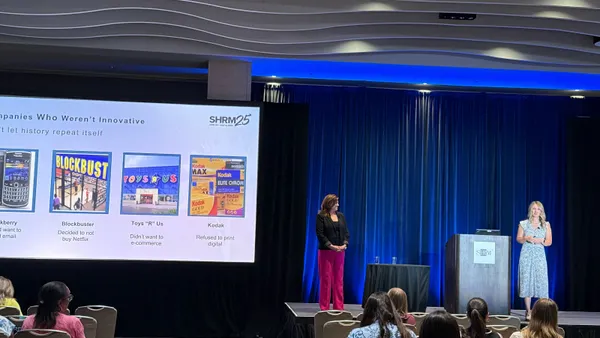Thanks to massive growth and years of innovation, experts feel confident enough to say: It is a golden age for learning.
The industry is changing quickly. Just between 2013 and 2014, the corporate learning industry experienced 21% growth. New learning platforms are enabling new ways of doing things, leading to less complicated and more engaging learning tools. And the influx of millennial influence can't be ignored, either.
HR Dive spoke to various learning experts and industry leaders to discern what will define learning in 2016 and beyond. Below, we outline some of the trends we uncovered – and what they mean for HR departments going forward.
The rise of video and gamification
As the learning industry marches ahead, video has emerged as one of the most cost-effective learning tools on the market, Karin Hurt, CEO of Let's Grow Leaders, told HR Dive.
"If people want to learn how to do something, the first thing they do now is go to YouTube," Hurt said. Video courses are cheap for companies to adopt, especially compared to company retreats that require speaker bookings and lodging expenses.
Companies that make learning videos tend to focus on them being entertaining and engaging. Often, they are paired with gamification efforts for maximum effect.
"The people who produced my course are all millennials and they all said, 'You got to have gamification,' " Hurt said.
In turn, modern learning companies have largely turned to video solutions for their clients. The science behind adult learning theory and video is solid, John Ambrose, senior vice president of strategy at Skillsoft, said. Skillsoft is an e-learning provider with a strong focus on video, Ambrose added.
"If you go back even 5 years ago, corporate networks were unable to deal with incoming video streaming," he said, noting its swift rise.
But companies have to be careful to incorporate different learning styles and preferences into their programs to make them truly effective.
"There is a lot of excitement around video," he said, "but it is important that it is delivered in context."
The classroom hasn't been abandoned just yet
While video and other e-learning modules have made strides, the old classroom isn't going away anytime soon.
Despite the high cost of physical training, some of the best learning programmers use materials like video to prepare employees before in-person trainings, shortening the time spent out of the office and maximizing the effectiveness of the shorter time spent together, Ambrose said.
"There has been a lot of re-exploring the whole classroom for training and its function," he said. "I think of it less as it falling out of favor and more of a mix issue."
To ensure balance, top learning programs lean toward multi-modal or "blended" styles that use the advantages provided by both e-learning programs and in-person education. Hurt's model uses video but gives exercises to learners to take back to their teams before they move on to the next module and involves a 360-degree feedback assessment from bosses and peers.
"I often see the trend toward more blended learnings and going back to a middle ground," Hurt said. "I've been talking to several companies about this being part of the larger curriculum of onboarding."
But be wary of "broadcast model" of learning, which is quickly falling out of favor, Iain Scholnick, CEO of Braidio, told HR Dive. Instead, learning is shifting toward a more collaborative model, one he calls a "streaming" model of learning.
"You are learning from your feed," he said. "Learning is a much more ongoing and continuous experience, not a separate place you go to."
Consumerization of learning and enterprise
One bonus of this new world of learning programs: many are moving away from the old complex learning management systems and toward simpler, more accessible tools.
Scholnick describes two complexities learning systems face: content and platform. Despite the great content these systems provide, many require IT support and are structured around long-term trainings that require intense commitment over the course of a workday. Now, programs are focusing on providing the "right learning for the right person at the right time," Ambrose said.
"It is less like a traditional enterprise and more like Spotify and Pandora and shopping on Amazon. It can tailor to your needs. It gets smarter as you interact overtime," he added. That way, learners don't need to commit to an eight hour session of learnings and can instead better customize their experience.
Diversity and millennials take center stage
Since trainings are often part of the onboarding process, it's no surprise that diversity training programs have increased in popularity. Modules that focus on diversity and company culture are some of Braidio's best sellers, Scholnick said.
"If you are thinking in a diverse way inside your company, it doesn't just become a messaging tool. It is key to your success," he added. Cultural engagement and creating an environment of safety not only establishes a stronger workplace but extends the company's reach into other marketplaces that can be engaged with.
Overall, the experts agreed that millennials are certainly driving many of these changes, especially toward "lighter-weight" learning tools that are mobile-accessible. User experience has become a real focus of learning companies, especially now that the technology (namely mobile phones) is more accessible than ever.
"Learning needs a better user experience, more dimensionality," Scholnick said. "Not just for the UI, but the experience around what learning means to you."
Check out all of our stories on employee learning and development here.












